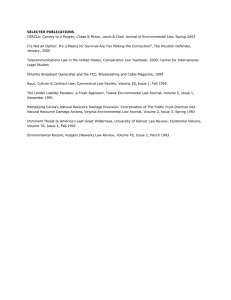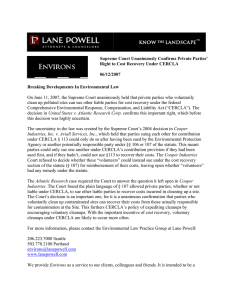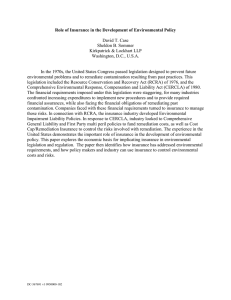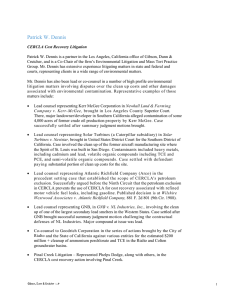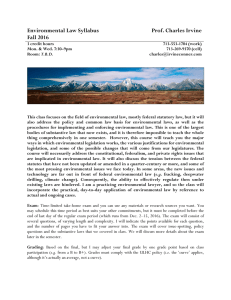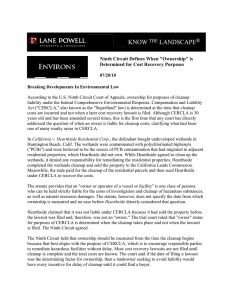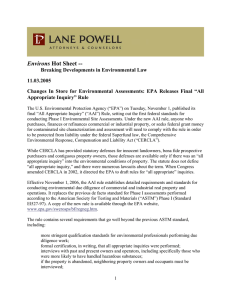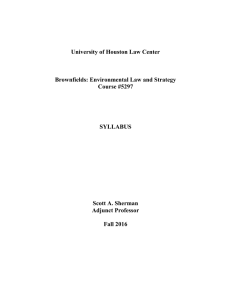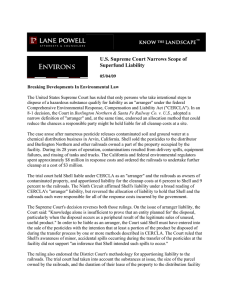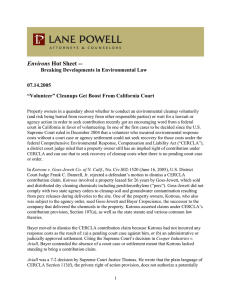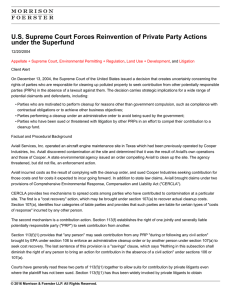C orporate ounsel T h e M e t r o...
advertisement
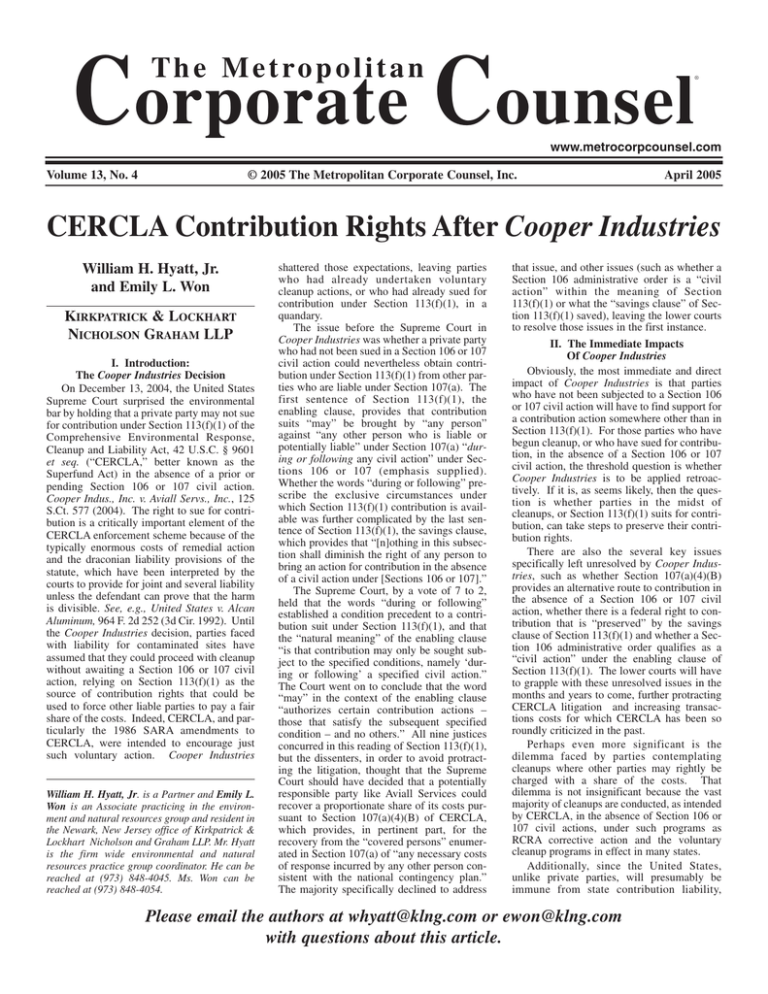
Corporate Counsel The Metropolitan ® www.metrocorpcounsel.com Volume 13, No. 4 © 2005 The Metropolitan Corporate Counsel, Inc. April 2005 CERCLA Contribution Rights After Cooper Industries William H. Hyatt, Jr. and Emily L. Won KIRKPATRICK & LOCKHART NICHOLSON GRAHAM LLP I. Introduction: The Cooper Industries Decision On December 13, 2004, the United States Supreme Court surprised the environmental bar by holding that a private party may not sue for contribution under Section 113(f)(1) of the Comprehensive Environmental Response, Cleanup and Liability Act, 42 U.S.C. § 9601 et seq. (“CERCLA,” better known as the Superfund Act) in the absence of a prior or pending Section 106 or 107 civil action. Cooper Indus., Inc. v. Aviall Servs., Inc., 125 S.Ct. 577 (2004). The right to sue for contribution is a critically important element of the CERCLA enforcement scheme because of the typically enormous costs of remedial action and the draconian liability provisions of the statute, which have been interpreted by the courts to provide for joint and several liability unless the defendant can prove that the harm is divisible. See, e.g., United States v. Alcan Aluminum, 964 F. 2d 252 (3d Cir. 1992). Until the Cooper Industries decision, parties faced with liability for contaminated sites have assumed that they could proceed with cleanup without awaiting a Section 106 or 107 civil action, relying on Section 113(f)(1) as the source of contribution rights that could be used to force other liable parties to pay a fair share of the costs. Indeed, CERCLA, and particularly the 1986 SARA amendments to CERCLA, were intended to encourage just such voluntary action. Cooper Industries William H. Hyatt, Jr. is a Partner and Emily L. Won is an Associate practicing in the environment and natural resources group and resident in the Newark, New Jersey office of Kirkpatrick & Lockhart Nicholson and Graham LLP. Mr. Hyatt is the firm wide environmental and natural resources practice group coordinator. He can be reached at (973) 848-4045. Ms. Won can be reached at (973) 848-4054. shattered those expectations, leaving parties who had already undertaken voluntary cleanup actions, or who had already sued for contribution under Section 113(f)(1), in a quandary. The issue before the Supreme Court in Cooper Industries was whether a private party who had not been sued in a Section 106 or 107 civil action could nevertheless obtain contribution under Section 113(f)(1) from other parties who are liable under Section 107(a). The first sentence of Section 113(f)(1), the enabling clause, provides that contribution suits “may” be brought by “any person” against “any other person who is liable or potentially liable” under Section 107(a) “during or following any civil action” under Sections 106 or 107 (emphasis supplied). Whether the words “during or following” prescribe the exclusive circumstances under which Section 113(f)(1) contribution is available was further complicated by the last sentence of Section 113(f)(1), the savings clause, which provides that “[n]othing in this subsection shall diminish the right of any person to bring an action for contribution in the absence of a civil action under [Sections 106 or 107].” The Supreme Court, by a vote of 7 to 2, held that the words “during or following” established a condition precedent to a contribution suit under Section 113(f)(1), and that the “natural meaning” of the enabling clause “is that contribution may only be sought subject to the specified conditions, namely ‘during or following’ a specified civil action.” The Court went on to conclude that the word “may” in the context of the enabling clause “authorizes certain contribution actions – those that satisfy the subsequent specified condition – and no others.” All nine justices concurred in this reading of Section 113(f)(1), but the dissenters, in order to avoid protracting the litigation, thought that the Supreme Court should have decided that a potentially responsible party like Aviall Services could recover a proportionate share of its costs pursuant to Section 107(a)(4)(B) of CERCLA, which provides, in pertinent part, for the recovery from the “covered persons” enumerated in Section 107(a) of “any necessary costs of response incurred by any other person consistent with the national contingency plan.” The majority specifically declined to address that issue, and other issues (such as whether a Section 106 administrative order is a “civil action” within the meaning of Section 113(f)(1) or what the “savings clause” of Section 113(f)(1) saved), leaving the lower courts to resolve those issues in the first instance. II. The Immediate Impacts Of Cooper Industries Obviously, the most immediate and direct impact of Cooper Industries is that parties who have not been subjected to a Section 106 or 107 civil action will have to find support for a contribution action somewhere other than in Section 113(f)(1). For those parties who have begun cleanup, or who have sued for contribution, in the absence of a Section 106 or 107 civil action, the threshold question is whether Cooper Industries is to be applied retroactively. If it is, as seems likely, then the question is whether parties in the midst of cleanups, or Section 113(f)(1) suits for contribution, can take steps to preserve their contribution rights. There are also the several key issues specifically left unresolved by Cooper Industries, such as whether Section 107(a)(4)(B) provides an alternative route to contribution in the absence of a Section 106 or 107 civil action, whether there is a federal right to contribution that is “preserved” by the savings clause of Section 113(f)(1) and whether a Section 106 administrative order qualifies as a “civil action” under the enabling clause of Section 113(f)(1). The lower courts will have to grapple with these unresolved issues in the months and years to come, further protracting CERCLA litigation and increasing transactions costs for which CERCLA has been so roundly criticized in the past. Perhaps even more significant is the dilemma faced by parties contemplating cleanups where other parties may rightly be charged with a share of the costs. That dilemma is not insignificant because the vast majority of cleanups are conducted, as intended by CERCLA, in the absence of Section 106 or 107 civil actions, under such programs as RCRA corrective action and the voluntary cleanup programs in effect in many states. Additionally, since the United States, unlike private parties, will presumably be immune from state contribution liability, Please email the authors at whyatt@klng.com or ewon@klng.com with questions about this article. Volume 13, No. 4 © 2005 The Metropolitan Corporate Counsel, Inc. except at federal facilities, Cooper Industries would appear to provide the federal government with a new defense strategy to avoid CERCLA liability, limiting its exposure in contribution to those instances in which the United States has instituted a Section 106 abatement action, or the United States, a state or a tribe has sued for Section 107 cost recovery. Since these instances represent only a small percentage of cleanup activity, Cooper Industries has effectively narrowed the government’s contribution exposure, notwithstanding the mandate of Section 120(a) that the United States “shall be subject to, and comply with [CERCLA] in the same manner and to the same extent, both procedurally and substantively, as any nongovernmental entity, including liability under [Section 107 of CERCLA].” The United States can effectively limit its contribution exposure by electing to use enforcement authorities other than civil actions under Sections 106 and 107 (such as Section 106 orders, RCRA enforcement actions, etc.), something private parties do not have the luxury of doing. III. Contribution After Cooper Industries All of this leaves private parties who have contribution rights to assert, but who have not been subjected to a Section 106 or 107 civil action, with limited options, all of which are complicated and lack certainty. First, of course, a private party that has not begun cleanup can refuse to do so until sued under Section 106 or 107. Putting aside the obvious fact that such a strategy would defeat one of the essential purposes of CERCLA, to promote prompt cleanup of hazardous sites, other unfavorable consequences are likely to follow from such an approach. First, the governments can recover their litigation costs, which could be considerable. Second, the governments might instead undertake to do the work and sue for cost recovery, thereby removing what might well be one of the most attractive options for the private party, controlling costs by doing the work itself. Third, litigation is simply unpredictable and a party inviting the government to sue it runs the risk that the litigation may result in unwanted surprises. Finally, such litigation sets up an adversarial relationship between the government and the private party that may manifest itself in ways that will increase the private party’s costs. Second, the private party can argue for a right to contribution on some basis other than the enabling clause of Section 113(f)(1). Examples of such arguments are (a) that Section 107(a)(4)(B) provides an express or implied right to contribution, an argument that appears to have been accepted by at least three of the sitting justices of the Supreme Court, and perhaps by more; (b) that there is a federal common law right to contribution implied in CERCLA; or (c) that some enforcement activity qualifies as the functional equivalent of a Section 106 or 107 civil action. For example, parties receiving Section 106 administrative orders may argue that such orders are “civil actions” under Section 106, but that argument has already been rejected by at least one district court. See Pharmacia Corp. v. Clayton Chem. Acquisition LLC., No. 02-cv-0428MJR, (S.D. Ill. Mar. 8, 2005). The dearth of definitive case law on any of these theories renders them suspect as means for immediate satisfaction. Third, a private party can consider filing suit pursuant to the citizen suit provisions under the Resource Conservation and Recovery Act (“RCRA”), 42 U.S.C. § 6901 et seq. The RCRA citizen suit provision provides a person may bring suit against any person . . . “who has contributed or who is contributing to the past or present handling, storage, treatment, transportation, or disposal of any solid or hazardous waste which may present an imminent or substantial endangerment to health or the environment.” This provision provides for broad substantive and procedural relief including injunctive relief and recovery of attorney fees but such a claim cannot be used to recover past costs. See, e.g., Interfaith Cmty. Org. v. Honeywell Int’l, Inc., Nos. 032760/ 3037/3585, 2005 U.S. App. LEXIS 2911 (3d Cir., Feb. 18, 2005). Fourth, the private party can attempt to obtain contribution through state law, although there is a risk that state law contribution schemes may be pre-empted by CERCLA. See In re Reading, 115 F.3d 1111 (3d Cir. 1997); Bedford Affiliates v. Sills, 156 F.3d 416 (2d Cir. 1998). Finally, there is the option of settlements with the United States or a state under Section 113(f)(3)(B), which provides that “[a] person who has resolved its liability to the United States or a state for some or all of a response action or for some or all of the costs of such action in an administrative or judicially approved settlement may seek contribution from any person who is not party to [such a settlement].” On the face of this provision, in order to qualify for contribution rights, at least four requirements must be met: (1) there must be at least a partial resolution of liability to the United States or a state, (2) for some or all of a response action or for some or all of the costs of such an action, (3) the resolved liability must be for “response” actions or costs, and (4) the resolution of liability must be documented in an administrative or judicially approved settlement. Although these four requirements would seem to be straightforward enough, the problem may well be that EPA and its counterpart state regulatory agencies lack the resources to grind out large numbers of these documents. Private parties should examine their preexisting settlements with EPA or states to determine if the Section 113(f)(3)(B) requirements are met. If further clarifying language is needed, companies should consider approaching a state or EPA to amend the settlement language. States particularly have a strong interest in encouraging cleanups and avoiding litigation, especially where they essentially give nothing up. The fact that twenty-three April 2005 state attorney generals filed an amicus brief in support of Aviall Services’ position and urged affirming the Fifth Circuit’s en banc decision indicates that at least some states are sympathetic to a PRP’s right to contribution. In addition, private parties should consult the relevant state agencies for recent pronouncements on how to handle such a settlement. For example, at least one state, Wisconsin, has adopted uniform provisions for inclusion in administrative settlements, designed to satisfy the above four criteria. See, e.g., State of Wisconsin’s Single Potential Responsible Party Model Settlement and Multiple Potential Responsible Party Model Settlement (available at http://www.dnr.wi.gov/org/aw/rr/general/whats_new.htm., as of March 10, 2005). Such parties should also consider whether Section 128, added to CERCLA in 2002 as part of the Small Business Liability and Brownfields Revitalization Act, might result in their having resolved their liability in states that have entered into memoranda of agreement with EPA under which a party’s participation in the state’s voluntary cleanup program precludes EPA from taking CERCLA enforcement action.1 Behind all these potential approaches is the possibility of a legislative fix, which could be as simple as eliminating the words “during or following” from the enabling clause of Section 113(f)(1), or adding the word “before” in front of that phrase in the statutory language. Any legislative effort will open up CERCLA to numerous proposals for amendments, including reinstatement of the lapsed Superfund tax. Each time CERCLA has been amended, substantial controversy has arisen over the proposed amendments and that is likely to be the case in connection with any attempt to correct the result of the Cooper Industries decision. IV. Conclusion Almost certainly, Cooper Industries has created more doubt about the meaning of CERCLA and will cause even more litigation than CERCLA has generated in the past. Parties considering undertaking cleanup activities in the absence of a Section 106 or 107 civil action, or being forced to undertake such cleanup under programs other than CERCLA, must carefully consider what strategy will best protect their contribution rights. Until the lower federal courts have interpreted Cooper Industries, and until the Supreme Court answers the questions that it specifically declined to resolve in Cooper Industries, developing a comprehensive strategy will be challenging. 1 New York, New Jersey and Connecticut have not entered into a Voluntary Cleanup Program MOA with EPA and Pennsylvania has entered into such a MOA. See Office of Solid Waste and Emergency Response Office of Brownfields Cleanup and Redevelopment, EPA, “States Brownfields and Voluntary Response Programs: An Update from the States,” (Jan. 2005) (available at http://www.epa.gov/brownfields/ pubs/st_res_prog_report.htm, as of March 10, 2005); see also One Cleanup Program Memorandum of Agreement between Commonwealth of Pennsylvania Department of Environmental Protection and Region 3 of the United States Environmental Protection Agency, dated 4/21/04 (available at www.dep.state.pa.us/dep/deputate/airwaste/wm/landrecy/facts/EPAMOA.htm, as of March 10, 2005).
